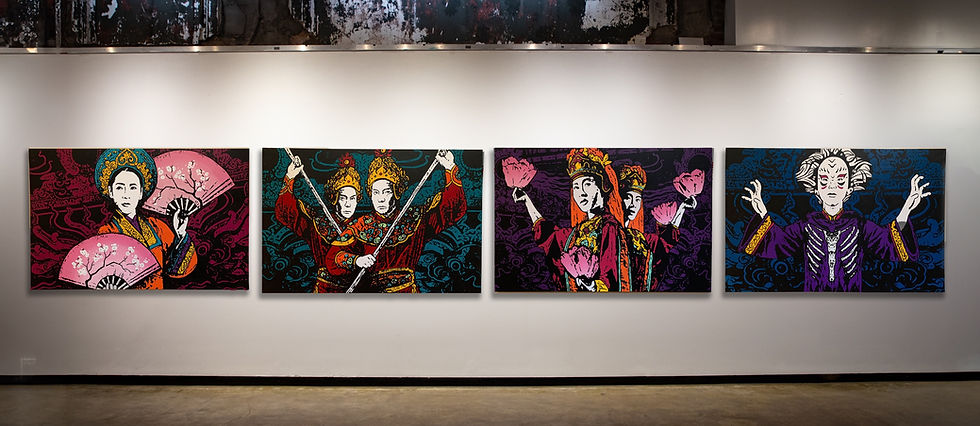Dancing Through Time: Exploring the UNESCO World Heritage Citadel Dancers in Hue, Vietnam
- Luke Stoffel

- Oct 9, 2023
- 3 min read
Updated: Jan 18, 2024
Hue, Vietnam
Artworks by Lucas Stoffel Fine art prints available on Etsy.

UNESCO Heritage Citadel Lantern Dancer of Hue, Vietnam by Lucas Stoffel
The city of Hue, is a place where history comes alive, and traditions dance through time. Nestled alongside the serene Perfume River, Hue is not just a UNESCO World Heritage Site; it's a treasure trove of Vietnam's rich cultural heritage. Today, we're embarking on a journey to explore one of its most captivating gems – the UNESCO-preserved tradition of the Dancers of the Citadel.
The Citadel: A Glimpse into Imperial Vietnam
In the heart of the city of Hue, stands the Hue Citadel. Built in the early 19th century, this massive fortress was once the royal residence of the Nguyen Dynasty emperors. Walking through its grand gates and lush gardens, you can't help but feel the weight of Vietnam's regal history.

UNESCO Heritage Citadel Fan Dancer of Hue, Vietnam by Lucas Stoffel
The Royal Court Dance: A Timeless Tradition:
My attention was drawn to a mesmerizing spectacle – the Royal Court Dance. This art form, once reserved for the imperial court, is a breathtaking blend of music, poetry, and dance. Each graceful movement tells a story, whether it's one of love, heroism, or spirituality.
The tradition of the Dancers of the Citadel dates back centuries. These talented artists were integral to the imperial court, entertaining emperors, dignitaries, and foreign guests with their exquisite performances. However, as Vietnam underwent significant historical changes, including war and shifts in political power, this cultural heritage faced the threat of extinction.
Recognizing the significance of this unique tradition, UNESCO designated the Complex of Hue Monuments, including the Citadel and its cultural practices, as a World Heritage Site in 1993. This official recognition marked a crucial step in preserving the Dancers of the Citadel tradition for future generations.

UNESCO Heritage Citadel Dancers of Hue, Vietnam by Lucas Stoffel
The Dance of Apsara:
One of the highlights of this performance is the Dance of Apsara. Here, the dancers embody celestial nymphs from Hindu and Buddhist mythology. Their costumes, adorned with vibrant silks and intricate embroidery, transport us to a realm where beauty and spirituality intertwine.

UNESCO Heritage Citadel Sword Dancers of Hue, Vietnam by Lucas Stoffel
The Dance of Warriors:
Another spellbinding segment is the Dance of Warriors. With swift and powerful movements, the dancers reenact ancient battles and heroic legends. It's a mesmerizing showcase of Vietnam's valor and honor.
The Role of Preservation:
UNESCO's preservation efforts encompass documentation, education, and performance. Talented artists, often trained from a young age, are tasked with passing down these intricate dances to ensure their survival. Workshops and performances both within Vietnam and on the global stage help raise awareness and appreciation for this remarkable cultural treasure.

UNESCO Heritage Citadel Masked Dancer of Hue, Vietnam by Lucas Stoffel
My exploration of the UNESCO-preserved tradition of the Dancers of the Citadel has been a journey through the annals of Vietnamese history and culture. It's a testament to the resilience of tradition, even in the face of changing times. As we admire the graceful movements and vibrant costumes of these artists, we leave with hearts full of appreciation for Vietnam's cultural heritage and a deep respect for those who dedicate their lives to preserving it. If you ever find yourself in Hue, don't miss the opportunity to witness this mesmerizing performance that dances through the ages, thanks to the enduring efforts of UNESCO.



Comments